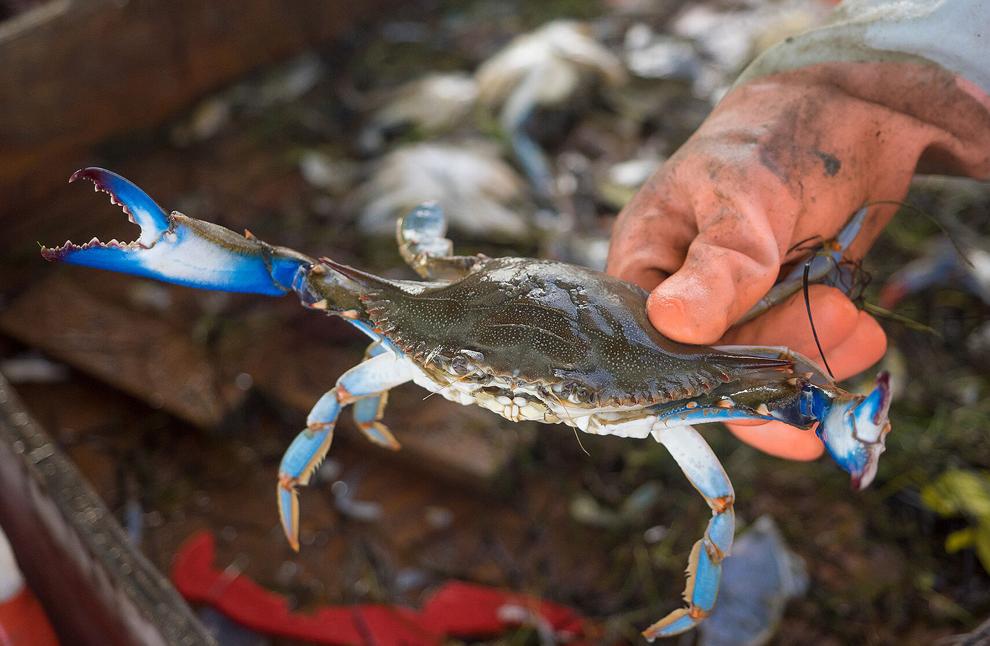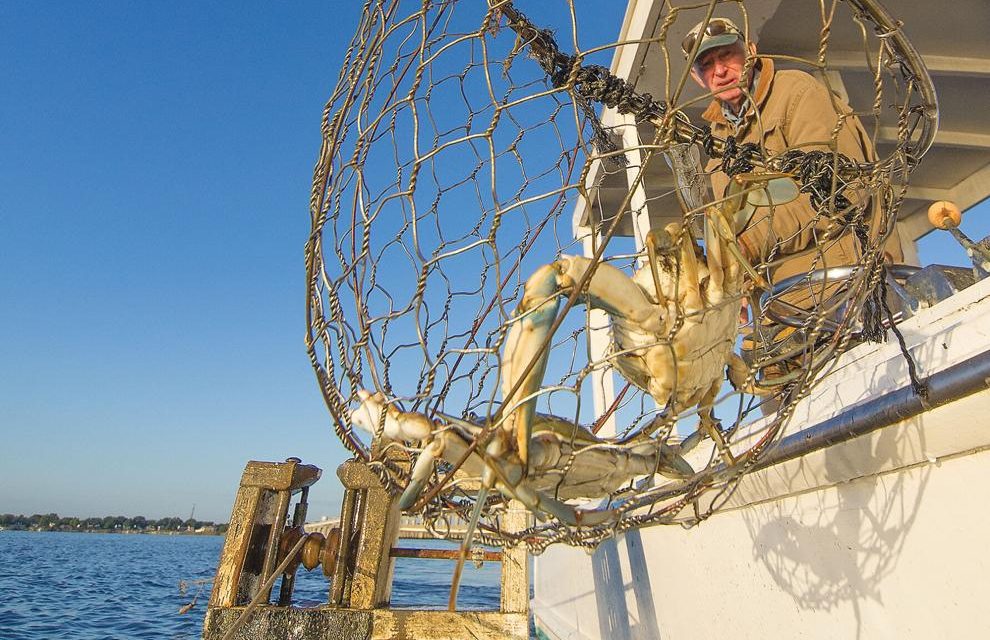By Jeremy Cox and Timothy B. Wheeler
Bay Journal
The Chesapeake Bay’s watermen are getting green lights to catch a few more blue crabs, a year after dismal population numbers led to steep cutbacks in their allowance.
The region’s fishery managers are far from confident that a surfeit of blue crabs now lurks beneath the Bay’s surf. But they say that results from the just-released wintertime survey were promising enough to relax some of the restrictions.
“We’re being cautious, but I think we’re being responsible,” said Ed Tankard, a board member with the Virginia Marine Resources Commission, which voted June 27 to ease certain bushel limits.
In Maryland, the state Department of Natural Resources announced on the same day a raft of industry-friendly changes to its crab controls, including modestly increasing the allowable harvest of female crabs and lifting limits on the harvest of males over Labor Day weekend.
Those moves came a few weeks after the panel that regulates the Potomac River’s fishing industry agreed to roll back bushel limits on female crabs to 2021 levels.
Crabbers disappointed
Crabbers, though, say they are disappointed that regulators didn’t give them more slack. Although the 2022 winter survey revealed the population to be at its lowest ebb on record, the commercial harvest went on to exceed expectations.
“We happened to have good fortune last year,” said Robert T. Brown, president of the Maryland Watermen’s Association. “Mother Nature was kind to us. [But] it seems like when Mother Nature is good to us, we get punished and penalized for it.”
This year, the winter survey, released May 18, estimated that the population had rebounded by 40%, increasing to about 323 million crabs. But that was still well below the historic average for the survey, which began in 1990.
“We manage based on trends,” Alexa Galván, a VMRC fishery management planner, told the agency’s board. “So, we are a little concerned about the [overall population] trend of being well below average in the last three years.”
In Virginia, regulators are offering a bit of relief to harvesters of all categories but are giving the biggest increases to the largest operations.
The VMRC sets restrictions based on the size of an operation’s permitted catch size. Under the standards approved at the board’s June 27 meeting, crabbers in the largest permit category will get to increase their daily harvests from 27 to 36 bushels per day. Except for the smallest class of permit-holders, the rest of the fishery will be allowed to keep an additional bushel per day as well.
Those changes apply only to the “low-bushel” periods from Oct. 1–Nov 30 and from March 17–May 15 next year. The board made no modifications to the crab season’s peaks of July 5–Sept. 30 this year and May 16–July 4 next year.
Last year, the largest harvesters in Virginia saw the biggest bushel cuts. Those licensees account for 13% of the operations but 38% of the catch, Galván said.

A young blue crab. Bay Journal photo by Dave Harp
This year’s modest boost in the Bay’s crab population in the wintertime survey made it possible for the agency to raise the overall catch limit, officials say. So, they set aside the bulk of that number for the largest category of harvesters to help offset the cuts they sustained last year.
Chris Moore, a Virginia-based scientist with the Chesapeake Bay Foundation, said that although the bushel increases could theoretically lead to heavier fishing pressure, the reality is that crabbers usually don’t max out their quotas. VMRC research shows that, from 2015–2022, nearly 9 out of 10 commercial outings during the height of the season returned to shore with 75% or less of their bushel limit.
“I think it was important to create an equitable conservation benefit across all pot categories,” Moore said. “This basically restored equity.”
The agency’s industry-dominated Crab Management Advisory Committee had unanimously supported the changes during its May meeting. But several crabbers urged the VMRC board to consider steps to allow more crabs to be brought ashore.
Peter Nixon, a Norfolk crabber and longtime advisory committee member, said he only sided with staff recommendations because he thought it was important to improve parity among the permit classes. He called on the board to lift the decade-old ban on dredging during the winter, arguing that it would provide crabbers with a much-needed source of income while only marginally raising the overall catch.
The VMRC left the door open to further easing, directing the crab advisory committee to meet in late August to re-evaluate the restrictions for the fall based on fresh data.
In Maryland, the seafood industry had sought the Labor Day reprieve to help meet the surge in demand over the Sept. 1–4 period, said Michael Luisi, assistant director of DNR Fishing and Boating Services. The agency’s staff offset that increase by adding four days at the beginning of October to limited harvesting.
Last year was the first time that Maryland officials had restricted the male harvest during August and September. Keeping those measures in place again this year will help ensure that the male catch doesn’t exceed the benchmark set to safeguard ample numbers for reproduction, Luisi said.
The male crab population hit a recorded low in last year’s winter dredge survey. This year’s small increase wasn’t big enough to persuade regulators to relax their harvest limits.
“We’re happy [the male population] increased,” Luisi said, “but it still hasn’t reached average yet.”
Maryland fishery managers also kept in place the reduction in bushels for recreational crabbers. They were cut from two to one last year.
The Potomac River Fisheries Commission, the bi-state panel that oversees fishing in that Bay tributary separating Maryland and Virginia, agreed June 8 to raise female bushel limits. Watermen with 400-pot licenses are seeing their daily limits rise from 12 to 16 bushels; 500-pot licenses are going from 16 to 20 bushels.
In addition, the commission decided that, starting in 2024, each person involved in recreational crabbing will need to obtain a sport crabbing license. Currently, the panel issues recreational licenses to a boat and a single person assigned to that vessel. The main goal of the change is to be better able to quantify recreational participation, officials say.
Scientists in the Chesapeake region aren’t sure what has been causing the dip in the number of crabs in recent years. Theories include predation from invasive species, declining water quality and a dearth of males to fertilize the females.
Researchers are so concerned that last year they agreed to undertake the first comprehensive stock assessment of the species since 2011.
Jeremy Cox is a Bay Journal staff writer based in Maryland. You can reach him at jcox@bayjournal.com. Timothy B. Wheeler is the Bay Journal‘s associate editor and senior writer, based in Maryland. You can reach him at twheeler@bayjournal.com.





Recent Comments